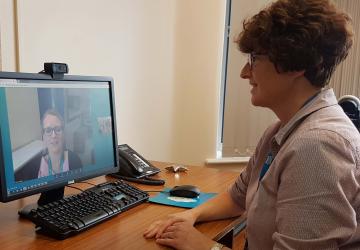
Speech Therapy in Prison part 2: The Therapist's Story
12th June 2020
In part one of this three-part article, Mark wrote about his experience of having therapy in prison. Here his speech and language therapist, Stephanie Burgess of Airedale NHS Foundation Trust, talks about working with Mark.
As Mark explained in his article, he is currently in prison and he has a stammer. As a child, he was told by his parents that if he couldn't talk properly, he shouldn't talk at all. This was the message he carried with him for the next forty-odd years. When I first saw Mark in May 2015 after he requested help for his stammer, I had little idea that we were about to embark on an amazing journey together.
I am an NHS speech & language therapist specialising in stammering, and work with both children and adults. At Airedale NHS Foundation Trust we have a well-established teletherapy service, providing remote video consultations between healthcare professionals and patients in their own homes, nursing homes and prisons.
Teletherapy
Working via video link throws up a number of potential challenges, such as connection problems and technical difficulties affecting the picture and sound quality. Working with people in prison is also a challenge. It can be difficult for clients to practise outside of the therapy sessions or to find someone they can talk to about their stammer. My experience is that there are often other people in the room with the prisoner during the therapy sessions, which can be quite noisy and distracting. Prisoners are frequently transferred between prisons, which happened with Mark, meaning I lost track of him for a while. Also he had no internet access, and could not therefore access online information or support groups.
I have seen a number of people in prison, and Mark's experience shows how effective this way of working can be.
Despite these barriers, the cost and security benefits of not having to transfer a prisoner to a local hospital for treatment more than outweigh the minor disadvantages of delivering the treatment by video. Over the last few years I have seen a number of people in prison, and Mark's experience shows how effective this way of working can be.
Working with Mark
At our first session Mark became very emotional and cried for most of the time. He told me that he had never really spoken to anyone about his stammer. He had asked for help as a child but did not receive any. Things had got so bad that he had dropped out of school at thirteen. He told me that with people he trusted he didn't mind stammering, but with people he didn’t know well, he tended to shut off, but then felt rude. He said that when he heard people chatting and laughing, he wanted to join in, but felt he couldn't.
Mark described himself as a loner, but my strong initial impression was that he was a naturally chatty, sociable person, feeling trapped into being a loner because of his stammer. He certainly came across as very eloquent and articulate. I didn't notice him stammer much, but he said that was because he was switching his words constantly. When I asked him what he wanted to achieve through therapy, he said he wanted to be able to talk to anyone, rather than having to pick and choose. He told me that he didn’t want sympathy, he just wanted people to listen to him and not finish his words.
This experience has made me reflect on how else in future to get across the message that there is no cure.
I wasn't aware until much later that Mark nearly didn't come back after that first session. Because he didn’t know what caused his stammer, he had apparently come full of hope that I could offer a cure. When Mark wrote about his experience of therapy, he said that it had crushed his hopes of 'being normal' when I told him there is no cure. This shocked me, as I have always tried to be honest with clients about expectations and the outcomes of therapy, and of course try to do so sensitively, but this experience has made me reflect on how else to get that message across in future.
Fortunately, an officer and some of his work colleagues persuaded Mark to come back, and over the next several months we met every two to three weeks, with a gap of several weeks in the middle when he transferred between prisons. We worked towards Mark's goals through a solution-focused approach, incorporating fluency techniques and encouraging acceptance and openness. Over the months, I saw a complete transformation in Mark, and that chatty, sociable person gradually began to emerge.
Setting goals
I was always impressed at Mark's willingness to try new things and to push himself out of his comfort zone. Each time we set specific goals for the following session, for example, for him to talk to people about therapy, to leave his cell more, to say his name when he came to the health centre, to make a list of 'scary' words and practise saying them using his new techniques, etc. Whenever he came back, he would always have achieved his goals, and usually more. Every few sessions, I sent him a summary of what we had talked about to help him to keep on track and to remind him of how far he had come.
I now wonder whether being in a prison environment actually helped.
After a couple of months, we reviewed his progress and I asked Mark what was helping the most. He said having set goals to work towards was motivating, as was knowing that he would have to 'report back' to me next time. We spent a lot of time talking about the process of change, and how difficult it can be. Mark told me that he had given up smoking the year before, and this was helping, because it had shown him that he had the ability to make changes in his life. I had thought that being in a prison environment would make change difficult, but I now wonder whether it actually helped, in that it gave Mark the time and space to reflect on things and practise new ways of speaking. It could also be that being in a structured environment helped him with goal setting. I asked Mark whether he felt disadvantaged by having his therapy via video link, but he said he liked it as it felt less daunting than being face to face.
Sharing Mark's story
I realised that Mark had an amazing story to tell and that it would be of interest to other people. When I first asked him if he would write it, he said he might write it for himself, but was quite adamant that he did not want it to be shared. I started to send other people's stories to Mark, which I printed from websites or copied from books, and he enjoyed reading these and could see the similarities with his own experience.
A significant moment in Mark's journey towards openness was when he put a poster on his cell wall saying, 'No Words are Scary'. This was his own idea, and he had put it up as a reminder to himself and to use as a personal mantra. However, what he also quickly discovered was that other people were interested in knowing what this meant, which encouraged him to talk about it. He was then able to see the advantages of raising awareness of stammering and the difficulties it can cause, and started wanting to get the word out more widely. I sent him some general information to share with people, and he wanted to be able to put this on the common room notice board, but the prison officers didn’t allow it as they felt it might lead to bullying.
When I saw Mark for our final therapy session, he told me that he had written his story and was happy for it to be shared. A couple of weeks later, an envelope with several hand-written pages arrived in the post. I am very glad that nobody else was around when I first read it, as I was an emotional wreck by the end. Since then, Mark's story has been widely shared and read, and its impact has been far-reaching, leading to developments Mark and I could never have foreseen.
Video
I was asked to present Mark's story to Airedale Trust's Executive Board. I felt it would have much more impact if it was Mark's own voice telling the story rather than mine, so I arranged to see Mark again and videoed him reading his story and answering questions about his experience of therapy. It was clear that Mark found this a difficult experience, and he broke down and cried several times, but he managed to get through it all. When I asked him afterwards what had changed for him as a result of his speech therapy, he told me, "I speak to everybody… I’ve got to like my own voice… Now I’m not bothered – if I stammer, I stammer… It feels to me it is sort of a cure, because I can say words I’ve never been able to say."
'Now I'm not bothered – if I stammer, I stammer… It feels to me it is sort of a cure, because I can say words I've never been able to say.'
When I showed the video, the feedback was overwhelmingly positive, and one of the Board members described it as 'the most impactful patient story I have ever heard'. Mark was astounded to hear that his story had been so widely shared and had such an amazing impact. When he received my letter telling him about it, he told me he had cried tears of joy and had instantly gone to telephone his daughter. Mark talked a lot about his daughter during our therapy sessions and his frustration at not being able to communicate with her the way he would like, so it was wonderful when she contacted me following the publication of Mark’s story to tell me what a huge difference speech therapy had made to Mark’s life and to their relationship.
National teletherapy service
After I sent Mark's story to the British Stammering Association, I received a phone call from their Chair, Tim Fell, who was keen to discuss my experience of delivering therapy via video and explore whether this was something that could be used to help others. As a result of this initial discussion, Airedale Trust entered into a partnership with the BSA to develop a national teletherapy service for adults who stammer. I am very excited to be heading up this project, which has the potential to help many people who are not currently able to access NHS speech therapy because of lack of local provision. The service is now up and running and you can find out more here.
Mark later said of his story in a letter he wrote to me: "I hope it will help therapists understand what people with a stammer go through and feel like before they go for help, and what life changes a therapist can help a person who stammers make. I'm living proof it works." I certainly learnt a huge amount from working with Mark and from his honesty and courage in describing how the experience of therapy had felt for him.
Mark said of his story: 'I hope it will help therapists understand what people with a stammer go through and feel like before they go for help, and what life changes a therapist can help a person who stammers make. I'm living proof it works.'
I am hugely grateful to Mark for allowing me to share his story. I am also grateful to the prison GP, who took Mark's concerns seriously when he asked for the referral to speech and language therapy, something which does not always happen, and to the prison healthcare team, who were supportive and encouraging of Mark while he was going through therapy.
Whatever happens to Mark in the future when he comes out of prison, I hope that this experience will help him to successfully reintegrate into society, and that his stammer will no longer hold him back from being the person he wants and deserves to be.
Read part three, in which Mark gives us an update on how things are going since leaving prison. Read part 1: Mark's story here.
Stephanie and her team won a Guardian Public Service award in 2017 for their outstanding achievement and their teletherapy service is now available to adults in the UK if there is no NHS therapy stammering service in your area. See our Teletherapy page for information.

This article was first published on our old website in June 2016 and has been updated. Lead photo: Stephanie using teletherapy.

































